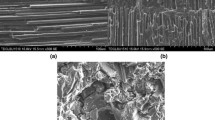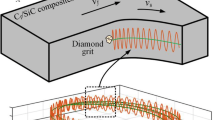Abstract
SiCf/SiC composites have been applied in numerous fields owing to their excellent out-of-plane properties, impact resistance, and delamination resistance. However, such composites are hard and brittle, and thus result in the formation of defects. In this study, we analyse the removal mechanism of different regions of the SiCf/SiC composites. Additionally, we investigate the effects of machining variables (spindle speed, feed rate and cutting depth) on the grinding force and surface roughness of SiCf/SiC composites in conventional grinding (CG) and ultrasonic-assisted grinding (UAG). The composites exhibit damage in the forms of matrix breakage, matrix cracks, fibre fracture, fibre debonding and interfacial debonding. The fibre removal modes in CG and UAG are different. Brittle fracture is the predominant material removal mechanism in CG and UAG. Results show that the grinding force and surface roughness decrease as the spindle speed increases, whereas they increase with the feed rate and cutting depth. Compared with CG, UAG is a more efficient and precise material processing method for reducing the grinding force and improving the machined surface quality. The findings of this study offer meaningful guidelines for improving the grinding process and machining efficiency of SiCf/SiC composites.
















Similar content being viewed by others
Data availability
All data generated or analysed during this study are included in this article.
References
Wang P, Liu F, Wang H, Li H, Gou Y (2019) A review of third generation SiC fibres and SiCf/SiC composites. J Mater Sci Technol 35:2743–2750. https://doi.org/10.1016/j.jmst.2019.07.020
Bhatt RT, Sola-Lopez F, Halbig MC, Jaskowiak MH (2022) Thermal stability of CVI and MI SiC/SiC composites with Hi-Nicalon™-S fibres. J Eur Ceram Soc 42:3383–3394. https://doi.org/10.1016/j.jeurceramsoc.2022.03.009
Duan Y, Qiu H, Yang T, Wang L, Wang X (2021) Flexural failure mechanism of 2.5D woven SiCf/SiC composites: combination of acoustic emission, digital image correlation and X-ray tomography. Compos Commun 28:100921. https://doi.org/10.1016/j.coco.2021.100921
Zhang Z, Yuan S, Xu W, Ouyang X, Zhang J, An W (2022) Damage behavior and removal mechanism of different yarn orientations 2.5D SiCf/SiC composites under single-abrasive scratch test. Ceram Int 48:30868–30883. https://doi.org/10.1016/j.ceramint.2022.07.041
Yin J, Xu J, Ding W, Su H (2021) Effects of grinding speed on the material removal mechanism in single grain grinding of SiCf/SiC ceramic matrix composite. Ceram Int 47:12795–12802. https://doi.org/10.1016/j.ceramint.2021.01.140
Cui G, Luo R, Wang L, Huang P, Song J, Wang J (2021) Mechanical properties evolution of SiCf/SiC composites with a BN/SiC multilayer interface oxidized at elevated temperature. Appl Surf Sci 570:151065. https://doi.org/10.1016/j.apsusc.2021.151065
Li C, Zhang F, Meng B, Liu L, Rao X (2017) Material removal mechanism and grinding force modelling of ultrasonic vibration assisted grinding for SiC ceramics. Ceram Int 43:2981–2993. https://doi.org/10.1016/j.ceramint.2016.11.066
Yang Z, Zhu L, Ni C, Ning J (2019) Investigation of surface topography formation mechanism based on abrasive-workpiece contact rate model in tangential ultrasonic vibration-assisted CBN grinding of ZrO 2 ceramics. Int J Mech Sci 155:66–82. https://doi.org/10.1016/j.ijmecsci.2019.02.031
Ding K, Fu Y, Su H, Chen Y, Yu X, Ding G (2014) Experimental studies on drilling tool load and machining quality of C/SiC composites in rotary ultrasonic machining. J Mater Process Technol 214:2900–2907. https://doi.org/10.1016/j.jmatprotec.2014.06.015
Huang C, Zhou M, Zhang H (2021) A cutting force prediction model in axial ultrasonic vibration end grinding for BK7 optical glass considering protrusion height of abrasive grits. Meas J Int Meas Confed 180:109512. https://doi.org/10.1016/j.measurement.2021.109512
Qu W, Wang K, Miller MH, Huang Y, Chandra A (2000) Using vibration-assisted grinding to reduce subsurface damage. Precis Eng 24:329–337. https://doi.org/10.1016/S0141-6359(00)00043-X
Wen Y, Tang J, Zhou W, Zhu C (2019) Study on contact performance of ultrasonic-assisted grinding surface. Ultrasonics 91:193–200. https://doi.org/10.1016/j.ultras.2018.08.009
Wang Y, Lin B, Cao X, Wang S (2014) An experimental investigation of system matching in ultrasonic vibration assisted grinding for titanium. J Mater Process Technol 214:1871–1878. https://doi.org/10.1016/j.jmatprotec.2014.04.001
Zhang X, Yang L, Wang Y, Lin B, Dong Y, Shi C (2020) Mechanism study on ultrasonic vibration assisted face grinding of hard and brittle materials. J Manuf Process 50:520–527. https://doi.org/10.1016/j.jmapro.2020.01.003
Wang Y, Lin B, Wang S, Cao X (2014) Study on the system matching of ultrasonic vibration assisted grinding for hard and brittle materials processing. Int J Mach Tools Manuf 77:66–73. https://doi.org/10.1016/j.ijmachtools.2013.11.003
Zhou W, Tang J, Chen H, Shao W (2019) A comprehensive investigation of surface generation and material removal characteristics in ultrasonic vibration assisted grinding. Int J Mech Sci 156:14–30. https://doi.org/10.1016/j.ijmecsci.2019.03.026
Dai C, Yin Z, Wang P, Miao Q, Chen J (2021) Analysis on ground surface in ultrasonic face grinding of silicon carbide (SiC) ceramic with minor vibration amplitude. Ceram Int 47:21959–21968. https://doi.org/10.1016/j.ceramint.2021.04.214
Wang Y, Sarin VK, Lin B, Lin H, Gillard S (2016) Feasibility study of the ultrasonic vibration filing of carbon fibre reinforced silicon carbide composites. Int J Mach Tools Manuf 101:10–17. https://doi.org/10.1016/j.ijmachtools.2015.11.003
Zhang L, Ren C, Ji C, Wang Z, Chen G (2016) Effect of fibre orientations on surface grinding process of unidirectional C/SiC composites. Appl Surf Sci 366:424–431. https://doi.org/10.1016/j.apsusc.2016.01.142
Liu Q, Huang G, Fang C, Cui C, Xu X (2017) Experimental investigations on grinding characteristics and removal mechanisms of 2D–Cf/C-SiC composites based on reinforced fibre orientations. Ceram Int 43:15266–15274. https://doi.org/10.1016/j.ceramint.2017.08.064
Cao X, Lin B, Zhang X (2015) Investigations on grinding process of woven ceramic matrix composite based on reinforced fibre orientations. Compos Part B Eng 71:184–192. https://doi.org/10.1016/j.compositesb.2014.11.029
Balaji R, Sivakumar S, Nadarajan M, Selokar A (2019) A recent investigations: effect of surface grinding on CFRP using rotary ultrasonic machining. Mater Today Proc 18:5209–5218. https://doi.org/10.1016/j.matpr.2019.07.521
Ning FD, Cong WL, Pei ZJ, Treadwell C (2016) Rotary ultrasonic machining of CFRP: a comparison with grinding. Ultrasonics 66:125–132. https://doi.org/10.1016/j.ultras.2015.11.002
Wang H, Ning F, Hu Y, Cong W (2018) Surface grinding of CFRP composites using rotary ultrasonic machining: a comparison of workpiece machining orientations. Int J Adv Manuf Technol 95:2917–2930. https://doi.org/10.1007/s00170-017-1401-z
Ning F, Wang H, Hu Y, Cong W, Zhang M, Li Y (2017) Rotary ultrasonic surface machining of cfrp composites: a comparison with conventional surface grinding. Procedia Manuf 10:557–567. https://doi.org/10.1016/j.promfg.2017.07.049
Li H, Lin B, Wan S, Wang Y, Zhang X (2016) An experimental investigation on ultrasonic vibration-assisted grinding of SiO2f/SiO2 composites. Mater Manuf Process 31:887–895. https://doi.org/10.1080/10426914.2015.1090586
Wang J, Zhang J, Feng P (2017) Effects of tool vibration on fibre fracture in rotary ultrasonic machining of C/SiC ceramic matrix composites. Compos Part B Eng 129:233–242. https://doi.org/10.1016/j.compositesb.2017.07.081
Liang Y, Chen Y, Zhu Y, Ji J, Ding W (2021) Investigations on tool clogging and surface integrainy in ultrasonic vibration-assisted slot grinding of unidirectional CFRP. Int J Adv Manuf Technol 112:1557–1570. https://doi.org/10.1007/s00170-020-06364-w
Zhang Z, Yuan S, Gao X, Xu W, Zhang J, An W (2022) Analytical modelling of side grinding of orthogonal laminated SiCf/SiC composites based on effective elastic properties. Int J Adv Manuf Technol 120:6419–6434. https://doi.org/10.1007/s00170-022-09170-8
Huang C, Zhou M, Zhang H (2021) A cutting force prediction model in axial ultrasonic vibration end grinding for BK7 optical glass considering protrusion height of abrasive grains. Meas J Int Meas Confed 180:109512. https://doi.org/10.1016/j.measurement.2021.109512
Li Y, Ge X, Wang H (2019) Study of material removal mechanisms in grinding of C/SiC composites via single-abrasive scratch tests. Ceram Int 45:4729–4738. https://doi.org/10.1016/j.ceramint.2018.11.165
Jamshidi H, Budak E (2020) An analytical grinding force model based on individual grit interaction. J Mater Process Technol 283:116700. https://doi.org/10.1016/j.jmatprotec.2020.116700
Jamshidi H, Gurtan M, Budak E (2019) Identification of active number of grits and its effects on mechanics and dynamics of abrasive processes. J Mater Process Technol 273. https://doi.org/10.1016/j.jmatprotec.2019.05.020
Li Z, Yuan S, Ma J, Shen J, Batako A (2021) Study on the surface formation mechanism in scratching test with different ultrasonic vibration forms. J Mater Process Technol 294:117108. https://doi.org/10.1016/j.jmatprotec.2021.117108
Lv D, Tang Y, Wang H, Huang Y (2013) Experimental investigations on subsurface damage in rotary ultrasonic machining of glass BK7. Mach Sci Technol 17:443–463. https://doi.org/10.1080/10910344.2013.806114
Wang D, Lu S, Xu D, Zhang Y (2020) Research on material removal mechanism of C/SiC composites in ultrasound vibration-assisted grinding. Materials (Basel) 13:1–14. https://doi.org/10.3390/MA13081918
Orowan E (1949) Fracture and strength of solids. Reports Prog Phys 12:185–232. https://doi.org/10.1088/0034-4885/12/1/309
Wang H, Hu Y, Cong W, Hu Z (2019) A mechanistic model on feeding-directional cutting force in surface grinding of CFRP composites using rotary ultrasonic machining with horizontal ultrasonic vibration. Int J Mech Sci 155:450–460. https://doi.org/10.1016/j.ijmecsci.2019.03.009
Baraheni M, Amini S (2020) Mathematical model to predict cutting force in rotary ultrasonic assisted end grinding of Si3N4 considering both ductile and brittle deformation. Meas J Int Meas Confed 156:107586. https://doi.org/10.1016/j.measurement.2020.107586
Zhang M, Pang Z, Jia Y, Shan C (2022) Understanding the machining characteristic of plain weave ceramic matrix composite in ultrasonic-assisted grinding. Ceram Int 48:5557–5573. https://doi.org/10.1016/j.ceramint.2021.11.100
Gavalda Diaz O, Axinte DA, Butler-Smith P, Novovic D (2019) On understanding the microstructure of SiC/SiC ceramic matrix composites (CMCs) after a material removal process. Mater Sci Eng A 743:1–11. https://doi.org/10.1016/j.msea.2018.11.037
Xue F, Zheng K, Liao W, Shu J, Dong S (2021) Investigation on fiber fracture mechanism of c/sic composites by rotary ultrasonic milling. Int J Mech Sci 191. https://doi.org/10.1016/j.ijmecsci.2020.106054
Funding
This work is supported by the Science Center for Gas Turbine Project (P2022-A-IV-002-002).
Author information
Authors and Affiliations
Contributions
Zikang Zhang: methodology, experiments, writing-original draft, writing-review and editing; Songmei Yuan: funding acquisition, writing-review and editing; Qilin Li: methodology, supervision and experiments; Xiaoxing Gao: supervision; Xinlu Ouyang: methodology and experiments; Yang Luo: experiments.
Corresponding author
Ethics declarations
Ethics approval
Not applicable.
Consent to participate
Not applicable.
Consent for publication
Not applicable.
Competing interests
The authors declare no competing interests.
Additional information
Publisher's note
Springer Nature remains neutral with regard to jurisdictional claims in published maps and institutional affiliations.
Rights and permissions
Springer Nature or its licensor (e.g. a society or other partner) holds exclusive rights to this article under a publishing agreement with the author(s) or other rightsholder(s); author self-archiving of the accepted manuscript version of this article is solely governed by the terms of such publishing agreement and applicable law.
About this article
Cite this article
Zhang, Z., Yuan, S., Li, Q. et al. Investigation on the machined surface quality and removal mechanism of SiCf/SiC composites in ultrasonic-assisted grinding. Int J Adv Manuf Technol 123, 4427–4445 (2022). https://doi.org/10.1007/s00170-022-10469-9
Received:
Accepted:
Published:
Issue Date:
DOI: https://doi.org/10.1007/s00170-022-10469-9




